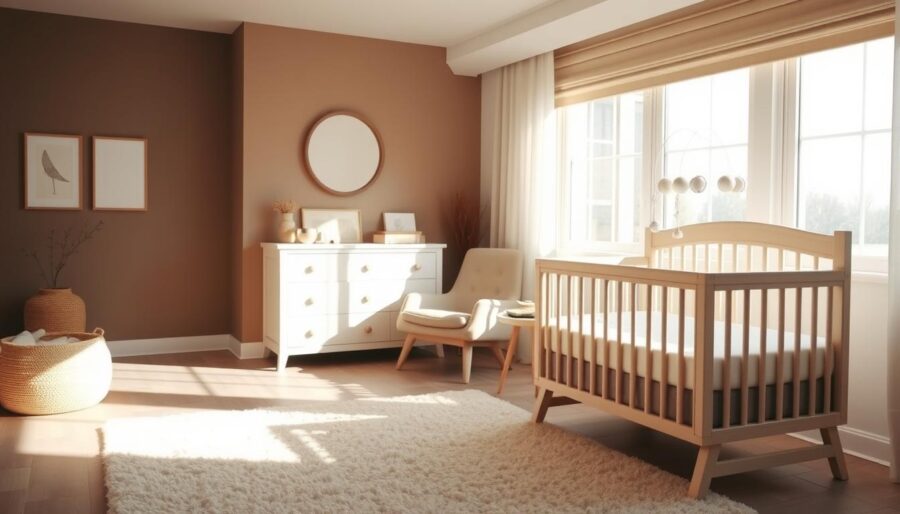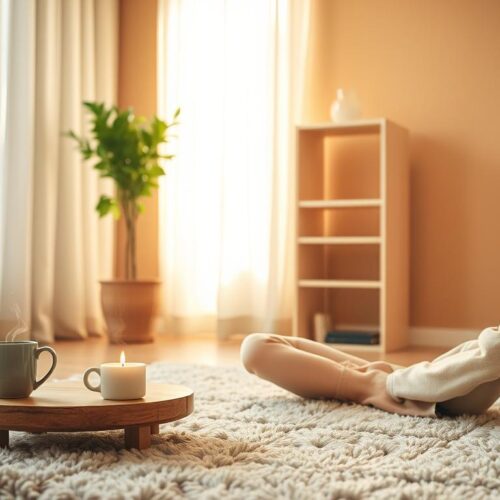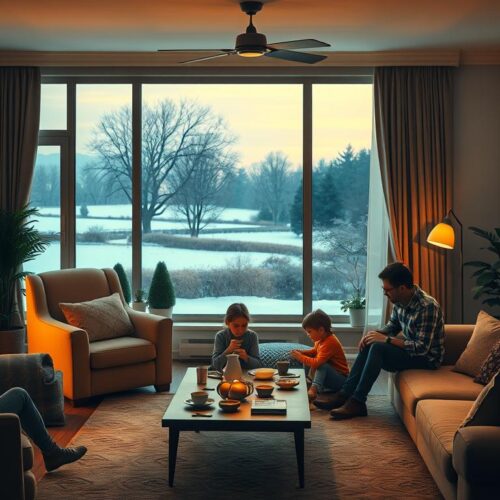You set the tone at home by shaping a space that reduces excess stimulation and supports both your baby’s rhythms and your need for relaxation.
Start with small, practical moves: dimmable lamps, soft textiles, quiet corners, and clear pathways so feeding and diaper changes flow with less stress.
Focus on the eight senses—sight, hearing, smell, taste, touch, vestibular, proprioception, and interoception—to meet your family’s unique needs rather than just decorating a nursery.
Use simple strategies like scent-free policies, sound dampening, varied seating, and go-to comforts so you can respond calmly during fussier moments.
Create spots where you can step away with your baby to regulate your system—rocking chairs, shaded nooks, or a window seat with a view.
Support for diverse individuals, including those with autism or anxiety, comes from planning ahead and treating this as a living system that adapts as your child grows.
Start Here: What a Sensory Calm Environment Means for Your Family
Identify the sights, sounds, and textures that regularly trigger fussiness, and prioritize fixes you can make this week. Start by listing your family’s needs and preferences so you know what soothes your baby and what helps you breathe easier.
Focus on simple, high-impact changes: soft lighting, lower noise, scent control, and tidy pathways. These choices reduce discomfort across the eight senses and support daily routines like feeds, naps, and bedtime.
- Clarify: Note what calms your child and what supports your relaxation.
- Prioritize: Fix the sense that most affects your daily experience first.
- Plan: Create a soothing nook, a movement area, and a quiet retreat everyone can use.
- Include: Teach all household individuals how to keep volumes and lighting steady.
| Change | Immediate Impact | Who Benefits | Why It Helps |
|---|---|---|---|
| Dimmable lighting | Faster winding down | Baby, caregiver | Reduces visual overload and supports naps |
| Decluttered pathways | Smoother caregiving | Whole household | Makes routines more predictable and safer |
| Quiet backdrop (steady sound) | Fewer startle reactions | Individuals with autism or high reactivity | Creates a reliable auditory cue for relaxation |
See these steps as a living plan. Adjust as your child grows and your thresholds shift, and embed relaxation into daily life so the whole system feels more manageable.
Assess Needs and Preferences Before You Redesign Your Space
Keep a short log of reactions to light, touch, movement, and sound so you can spot trends. Use a notes app or a printed checklist to capture what reliably soothes and what riles your child. This simple tool helps you track recovery time and repeatable strategies.
Rate each room by brightness, echo, clutter, and traffic. Give scores for sensory load so you can decide which small fixes will best regulate sensory processing for your family.
- Observe: Note squinting, startles, or movement-seeking across the day.
- Record: Jot which visuals, sounds, textures, and temperatures help.
- Test: Try 15-minute trials with a lamp, rug, or sound and keep what works.
| Action | Quick Win | Who Benefits |
|---|---|---|
| Short observation log | Clear patterns | Caregivers, baby |
| Room sensory rating | Targeted fixes | Whole household |
| Short trials | Less guesswork | Individuals with autism or high reactivity |
Talk with caregivers about predictable routines and add labels or quiet zones if anyone in your home has autism or other processing differences. Plan safety, set a modest budget, and treat this as a flexible system you can refine as your experience grows.
Create Calming with Light: Gentle, Adjustable Lighting Options
Choosing the right lighting can make late-night feeds and diaper changes less stressful. Swap harsh fluorescents for dimmable lamps with warm bulbs so you work in a softer, predictable glow that supports relaxation.
Use natural light during the day and blackout shades at nap time to control glare and lower visual stimulation. Layer lighting—small table lamps, string lights, or battery candles—so you can fine-tune brightness without startling your baby.
- Set a routine: one low lamp near the nursing chair and a clear path to the crib for smooth wind-downs.
- Reduce flicker: choose bulbs and shades that give even pools of light and cut harsh contrast for people with visual sensitivities or autism.
- Test placements: try a lamp position for a week and note what helps bedtime and what distracts your child’s gaze.
| Change | Quick Benefit | When to Use |
|---|---|---|
| Dimmable bedside lamp | Gentle light for feeds | Night care and feeding |
| Blackout shades | Reduced morning wake-ups | Naps and early mornings |
| Layered small lights | Flexible brightness control | Evening routines, quiet play |
Keep playful visual items like lava or bubble lamps out of sight during sleep windows. Store extra bulbs and night-lights so you maintain a steady atmosphere that meets your family’s needs and supports ongoing relaxation.
Tune the Soundscape: Calming Music, Nature Sounds, and Quiet Zones
Sound shapes routine—use gentle playlists to guide feeds, naps, and transitions. Start with soft instrumental tracks or steady nature sounds at low volume.
Create a predictable audio routine: pick playlists with steady tempos so breathing and heart rates can slow. Simple players or your phone work well for at-home and on-the-go use.
- Layer textiles like rugs and curtains to damp echoes and lower abrupt noises.
- Keep a quiet corner for feeds with a basic speaker behind cushions to diffuse direct sound.
- Have noise-canceling headphones available for adults or older siblings who need distance from sudden stimuli.
| Strategy | Quick Win | Who Benefits | When to Use |
|---|---|---|---|
| Predictable playlist | Smoother transitions | Baby, caregiver | Bath-to-bed, stroller-to-crib |
| Nature sounds loop | Lowered anxiety | Individuals with autism, sensitive listeners | Naps, winding down |
| Textiles & layout | Reduced echo | Whole household | Evening, busy rooms |
| Go-bag playlist | Less overwhelm outside | Caregiver, child | Stores, waiting rooms |
Test intervals of 20–30 minutes and note your preferences. Adjust volume or track type based on how your baby and you settle. Treat sound like lighting—layered and adjustable—so familiar cues support ongoing relaxation and a gentler experience.
Provide Deep Pressure and Tactile Comfort Safely
You can use gentle pressure techniques to help your baby build body awareness and settle faster during feeds, naps, or transitions.
Start with age-appropriate pressure. For newborns, snug swaddles, close-contact holding, and safe babywearing give predictable input. Never add heavy items on an infant.
As your child grows, create a supervised snuggle space — a small tent or soft corner with breathable pillows and large stuffed animals. For older toddlers, a zip-up duvet crash pad can provide safe proprioceptive play when watched closely.
- Choose soft, breathable materials and rotate textured loveys weekly to avoid overwhelm.
- Offer brief, gentle infant massage after baths and watch for signs that your child prefers lighter touch.
- Consider lap pads or compression wear for adults who need steady pressure during stressful moments.
| Item | Best Age | Benefit | Safety Note |
|---|---|---|---|
| Snug swaddle | 0–3 months | Predictable pressure for sleep | Use safe technique; stop at rolling |
| Soft snuggle corner | 6 months+ | Cozy, supervised rest or tummy time | Always supervise; avoid loose bedding |
| DIY crash pad (duvet zip) | 2 years+ | Proprioceptive play and input | Use heavy supervision; remove small parts |
| Lap pad / compression wear | Adults & older children | Steady pressure for regulation | Use as needed; follow manufacturer guidance |
Track how long pressure inputs help and use them before known stressors like car rides or nap time. Match your breathing to the hold—slow exhale while rocking—to boost calming benefit for both of you.
Movement Matters: Proprioception, Vestibular Input, and Body Awareness
Using predictable motion—like rocking, swaying, or paced walking—often reduces fussing and speeds settling for both baby and parent.

Proprioceptive input from muscles and joints builds body awareness and supports the whole regulation system. Gentle, rhythmic activities give steady feedback to the body and can be naturally calming.
Set up a safe rocking chair zone with soft lighting and a steady playlist so you have a reliable spot to soothe. Keep the area clear of trip hazards and place a firm surface nearby for supervised floor play.
- Use short movement “snacks” across the day—five minutes of rocking before naps or a stroller walk before bedtime.
- Try adult tools like an exercise ball for seated bouncing while your baby rests safely on a firm surface or in your arms.
- Encourage rolling and reaching on the floor to build early body awareness with low stimulation.
- Match motion to your baby’s head control and cues; avoid abrupt, high-intensity moves near sleep windows.
- Pair each movement with slow breaths—inhaling on the lift, exhaling on the rock—to cue relaxation.
| Tool / Activity | Best For | Benefit | Safety Notes |
|---|---|---|---|
| Rocking chair zone | Newborns & caregivers | Predictable vestibular input for soothing | Secure chair; clear floor space |
| Exercise ball (adult) | Caregiver regulation | Gentle bouncing to reduce caregiver stress | Keep baby on firm surface when bouncing |
| Floor rolling & reaching | 3–12 months | Proprioception for body awareness | Supervise; soft mat; remove small objects |
| Mini-trampoline (older kids) | 2 years+ | Vestibular and proprioceptive input | Use net or close supervision; limit near naps |
Simplify the Environment: Declutter, Organize, and Zone the Space
A simpler room helps you find what you need quickly and lowers the chance of overload.
Store toys and care items in labeled bins and keep only one or two choices available at a time. Rotate bins weekly so items feel new without creating extra visual stimulation.
Create clear zones: a soothing corner for rest, a play area, and a care station for diapering and feeding. This layout helps you move fast to the right spot and supports predictable routines.
- Keep high-traffic paths open and free of cords or low tables to reduce trips while carrying your baby.
- Place feeding, diapering, and pumping tools in consistent locations to cut decision fatigue.
- Use simple colors and fewer patterns in sleeping zones to lower visual load for all individuals, including those with autism.
| Action | Quick Result | Who Benefits |
|---|---|---|
| Labeled, rotated bins | Less clutter; sustained interest | Baby, caregiver |
| Clear zones | Faster transitions | Whole household |
| Five-minute tidy routine | Maintained relaxation | Individuals with varied needs |
Monitor how clutter returns and schedule quick tidies after key transitions. Adjust storage as your child grows so age-appropriate items stay reachable and distractions stay minimal.
Aromas, Temperature, and Sensory Play: Gentle Inputs That Soothe
Gentle aromas and steady temperatures can become predictable cues that help your whole household wind down. Keep most rooms scent-neutral and use neutral cleaners so you start from a known baseline.
When you do introduce scent, choose mild options—tiny hints of lavender or chamomile—and only use them briefly while your baby is calm. Never apply concentrated oils to skin or bedding. Store adult-only products securely out of reach.
Thermal comforts are low-effort: a warm bath, a cozy blanket for the caregiver, or a cool compress after a long day can signal relaxation. Check room temperature before sleep and adjust one variable at a time so you can pinpoint what helps.
- Try supervised sensory play as your child grows—water play with larger cups or rice bins for toddlers, soft fabric books for infants.
- Open windows for subtle nature cues when weather allows to reduce indoor stimulation without strong odors.
- Log aromas, temperatures, and responses so you can track preferences and support individuals with autism or other needs.
| Input | Quick Benefit | Safety Note |
|---|---|---|
| Mild aroma (brief) | Supports sleep cueing | Do not apply to baby; test once |
| Warm bath | Signals wind-down | Test water temp; supervise |
| Supervised tactile play | Builds exploration and comfort | Avoid small parts; watch closely |
How to Prevent and Recover from Sensory Overload
Start by spotting small shifts—short fuses, clenched hands, or turned-away eyes—so you can act before overload builds.
When you notice early signs, move to a quieter corner and reduce stimuli stepwise. Dim lights, lower sounds, and remove strong smells. These quick moves help reset your system and your baby’s mood.
Rely on familiar anchors: steady music or nature sounds at low volume, your voice, and a comfy chair. Use deep pressure like a snug blanket or a gentle hold to signal safety.

Use simple activities that work for you—warm baths, rocking, short walks, or slow stretches. Slow your breathing and match gentle movement to longer exhales so your body models relaxation.
- Keep a short recovery list (bath, walk, favorite blanket) so you act fast without overthinking.
- Avoid new strategies during overload; stick to proven tools you already own.
- Debrief later to note triggers and what helped, so next time your response is quicker.
| Step | Action | Why it Helps | Who Benefits |
|---|---|---|---|
| Spot early cues | Move to quiet zone | Prevents full overload | Caregiver, child |
| Dial down inputs | Dim lights, lower music | Reduces visual & auditory load | Individuals with autism, high reactivity |
| Use anchors | Nature sounds, familiar music | Cues predictability and safety | Whole household |
| Recovery activities | Warm bath, walking, gentle yoga | Regulated input and grounding | Caregiver, child |
Budget-Friendly DIY and Tools to Incorporate Sensory Support
With a few household items you can create pockets of predictable support for both child and caregiver.
Start with what you own: lamps with warm bulbs, spare blankets, a comfy chair, and a phone playlist deliver immediate benefits.
- Upgrade lighting options cheaply with string lights, battery candles, or diffusing shades to soften harsh glare.
- Make a DIY crash pad by stuffing a zippered duvet cover with pillows for supervised play and safe drops.
- Carve a snuggle space using a small tent or inflatable kiddie pool filled with soft items for a quick retreat.
- Test a tactile board on a removable panel using fabric swatches, bubble wrap, and smooth materials; keep small parts away from babies.
- Use a phone and small speaker to play steady beats or nature tracks at set times to create reliable audio cues.
- Try a hand-held massager for adults or older kids for vibration input, and switch to gentle rolling touch if vibration is disliked.
- Keep items in labeled, rotated bins to reduce clutter and maintain interest in the main space.
| Item | Quick Use | Benefit |
|---|---|---|
| String lights / battery candles | Evening lighting options | Low-cost light that reduces glare |
| DIY crash pad (duvet) | Supervised jumps | Provides deep pressure play for toddlers |
| Tactile board | Wall-mounted trial | Explore different materials safely |
| Phone playlist + speaker | On-demand music | Consistent audio input for routines |
Track what works before you buy new tools or materials. Document favorite setups so you can recreate the same settings after travel or schedule changes.
Conclusion
Conclusion
Wrap up by choosing three low-effort changes that match your family’s needs and preferences. Start small: softer lights, steady music, and one tidy zone to reduce stimulation and support relaxation.
Use short, repeatable sensory activities that fit daily routines so soothing becomes automatic during feeds, naps, and evenings. Track what works this week and keep that as your new baseline.
Honor accessibility for autism and other neurodivergent profiles by making cues predictable and adjustable. When your space supports your regulation, you both rest and connect more easily.
Trust your observations, iterate one variable at a time, and focus on comfort. These steps help you create calming routines that improve your daily experience and long-term relaxation.




